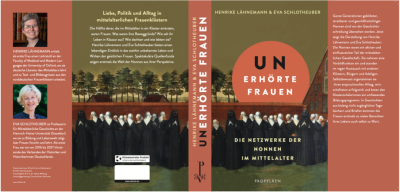
By Professor Henrike Lähnemann
Zehn, neun, acht, sieben, sechs … The voice of the woman behind one of the three big film cameras trails off as she leaves the three of us sitting on the long curved red sofa to finish the countdown for ourselves. It is 18:44:50 local time in the large ARD Studios near Hagenbeck’s Tiergarten in Hamburg on 21 December 2023. Eva Schlotheuber and I are here to talk about Unerhörte Frauen. Die Netzwerke der Nonnen im Mittelalter, a book we published on medieval nuns and their modern successors in the “Evangelische Klöster” of Northern Germany.
The book sets out to give the women back their voice. In their own time, they were highly influential, corresponding with those in power both secular and religious, administering their own business, giving out advice and successfully lobbying for their community via an effective network of a whole group of convents. Above all, as “brides of the highest king”, they were the direct link to Christ, their prayers a powerful mode of intercession. It is only in the modern period that as part of the denominational divide they became sidelined – seen by Protestant historiography as either locked-away poor souls or the caricature of the “sexy nuns”.
The sources we used for our book speak a different language: we followed the personal diary of a Cistercian nun from Heilig-Kreuz near Braunschweig which records in – not always flawless – Latin (she might have started it as an exercise book) the daily events, debates, feasts, visitors, educational reform – more than once I was amused by parallels to Governing Body discussions in an Oxford College. The other major body of texts we used are the 1,800 letters copied into three large volumes by the Benedictine nuns of Lüne near Lüneburg, one of the largest caches of writing by medieval women which we are editing in a Gerda Henkel Stiftung funded project, an astonishing untapped resource. We are currently working our way through the second of these volumes and they provide an extraordinary insight into the network of the nuns which they used to comfort, admonish, lobby, make jokes and gossip – in Latin verse and prose, in the Middle Low German dialect of the region and, particularly interesting, in a personal lingo used for communication between the convents in which they constantly code-switch between the two languages.
These documents survived in the Northern German convents because the nuns were successful in their communication strategy: their convents survived the Reformation and Secularisation as Protestant female religious communities. The current abbess of Kloster Lüne, Amélie Gräfin zu Dohna, is the 48th “head of house”.

It was this rich tradition and its continuity that we wanted to convey, and NDR DAS! provided the ideal platform for this. What started as a news magazine with local guests has become an iconic daily talk show with a fan basis well beyond the North of Germany – our session is the last regular broadcast before celebrating the 30 year anniversary of the programme. The evenings before had seen the pianist Yvor Levit, a professor of marine biology Anke Boetius and the actor Charles M. Huber.
Original video clips produced by the NDR are a particular feature; in our case they had sent a film team three times to Kloster Lüne to document our book presentation in summer, interview the abbess and capture the Gothic architecture with its medieval fountain, stained glass, and beautiful gardens in different seasons. The video clips punctuated the broadcast – and gave the presenter, the very experienced and knowledgeable Inka Schneider (she has been presenting the programme for 20 years!), the opportunity to quickly brief Eva Schlotheuber and myself where the next block of questions would take us. That really meant that from the countdown every second of the 45 minutes was used effectively and we managed to cover most of the topics we had touched upon in the book: education, music, food, healing, outreach, communication…, reading out quotations from the letters and recounting the stories of the diary.
The format of a TV talk show with nearly a million viewers might seem a strange setting for nuns whose vows meant a life in strict enclosure. But in a way the exchange on the red sofa continued what the nuns started with their prolific letter writing: a network of promoting learning, the well-being of the community and making their voices heard. Or as a nun noted on the flyleaf in one of manuscripts:
Salutis ad preludium / sit artis nobis studium: / wolan, die scryft vorstan!
quo sine stat in ocio / claustralis –heu! –devocio: / nicht lesen is ovel dan!
(For us, studying the Arts should be a prelude to salvation: Let us understand Scripture!
Without it, conventual devotion – alas! – is idle: it’s evil not to read!)
You can watch the interview (in German) with Eva Schlotheuber and myself on NDR DAS!
We are still looking for a catchy title for the English version of the book, due out in June with Open Book Publishers, that captures the pun of “Unerhörte Frauen” (unheard but also: unheard-of); suggestions so far have been: “Outrageous Habits”, “Unheard and Unherdable”, “Nunheard”, “Audacious and Inaudible” – none of which quite works. Further suggestions gratefully received!